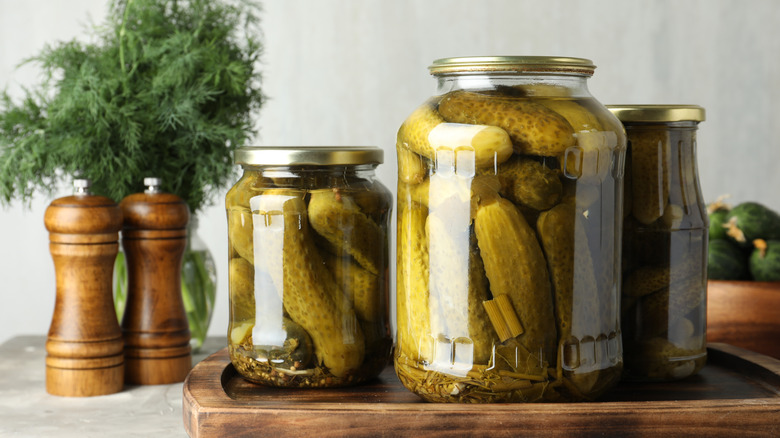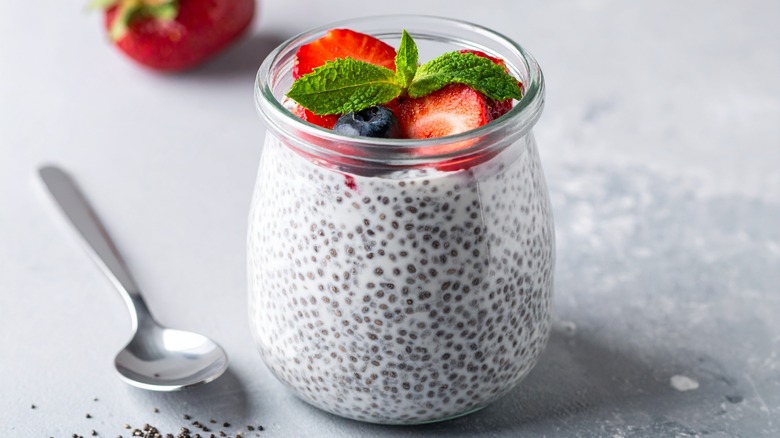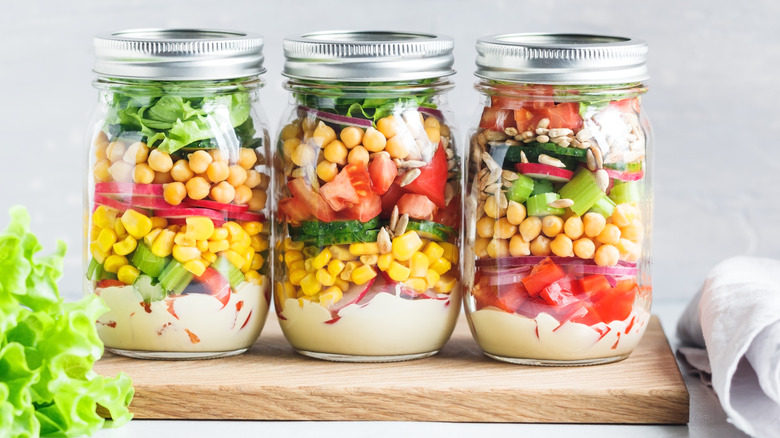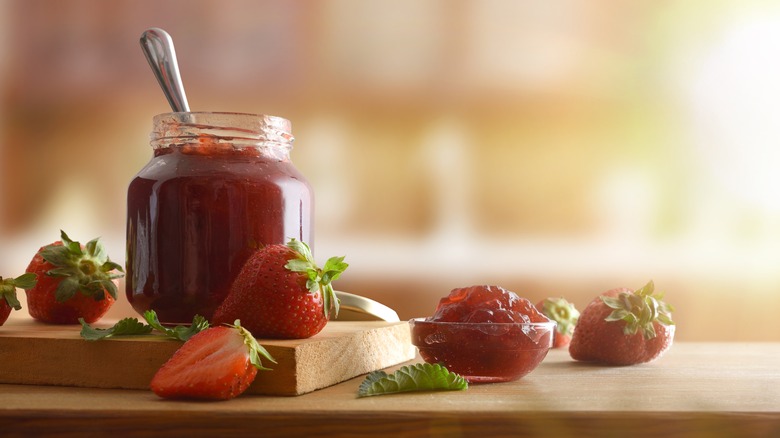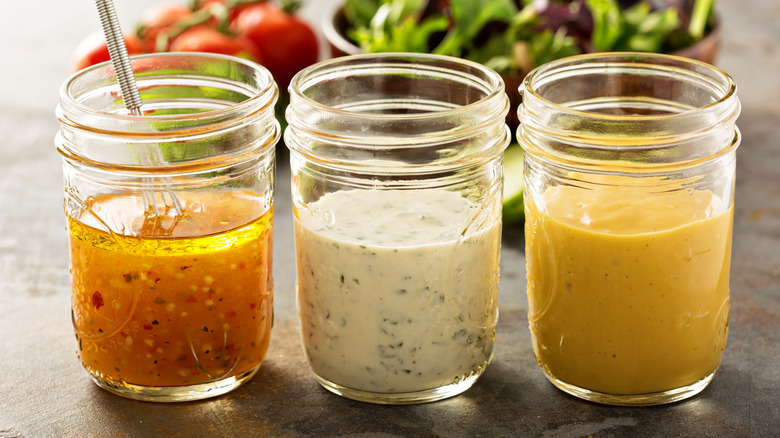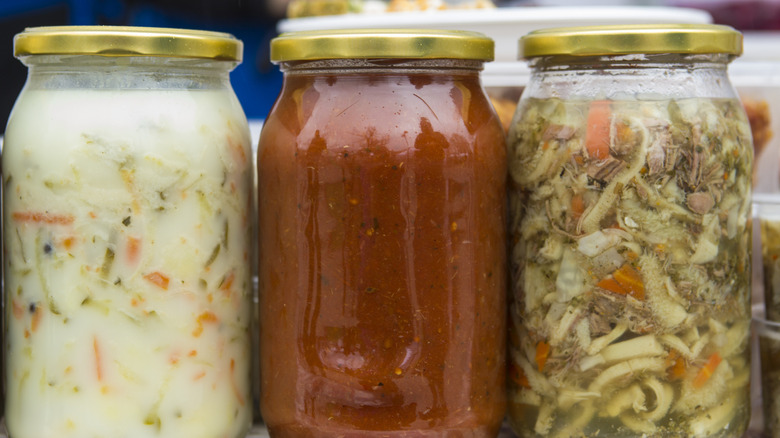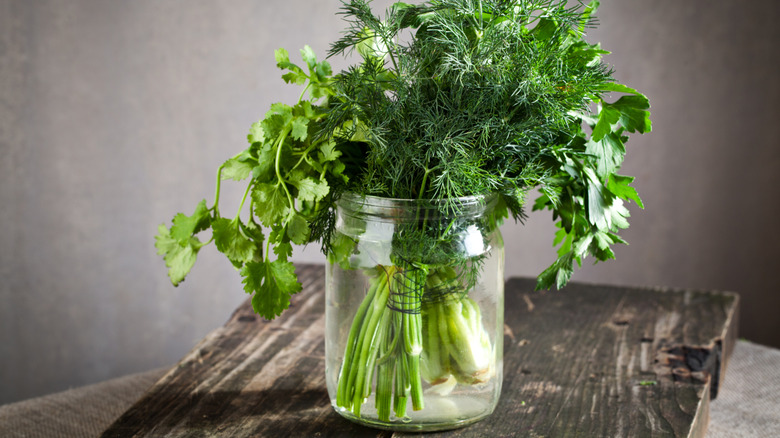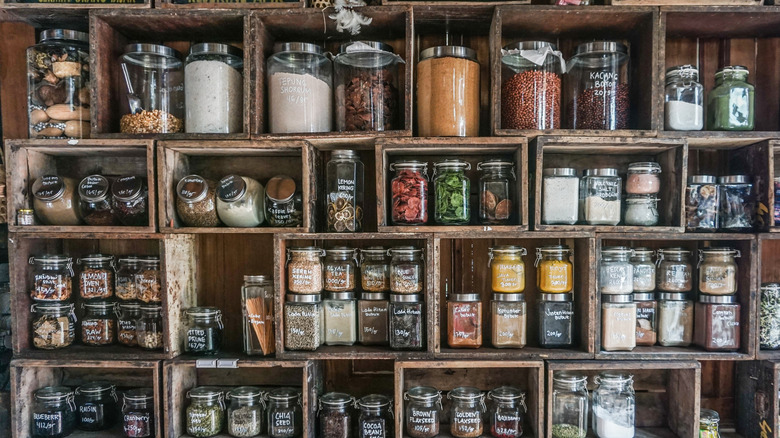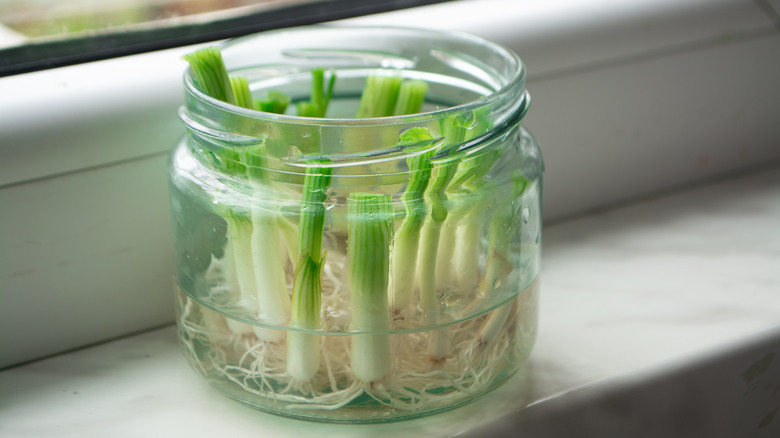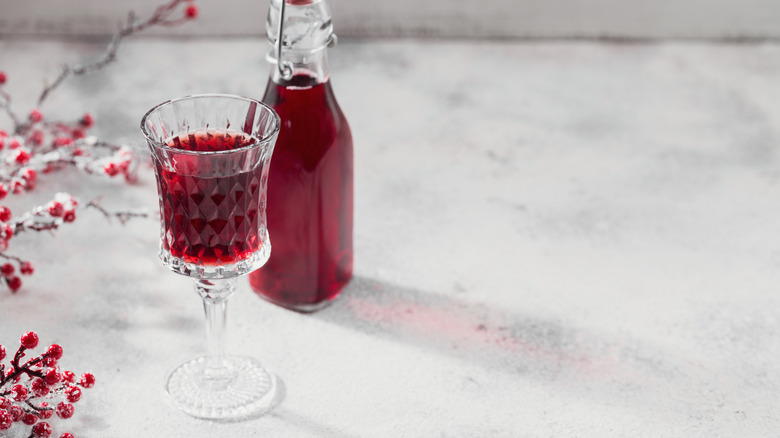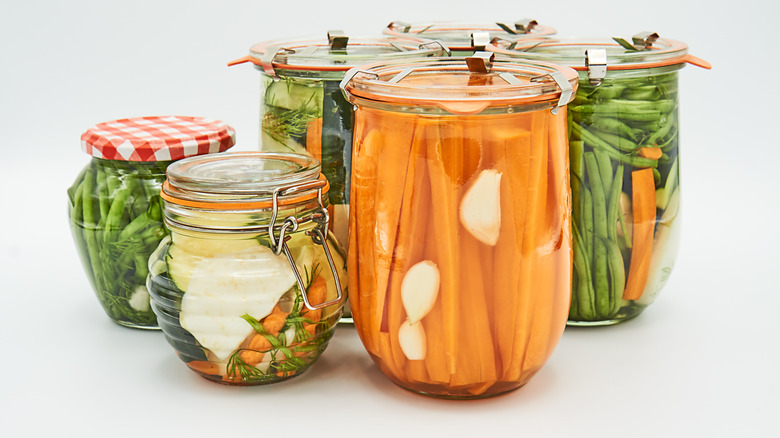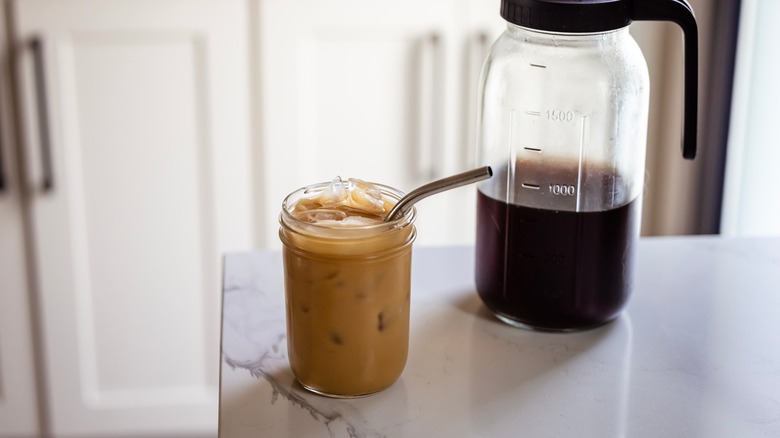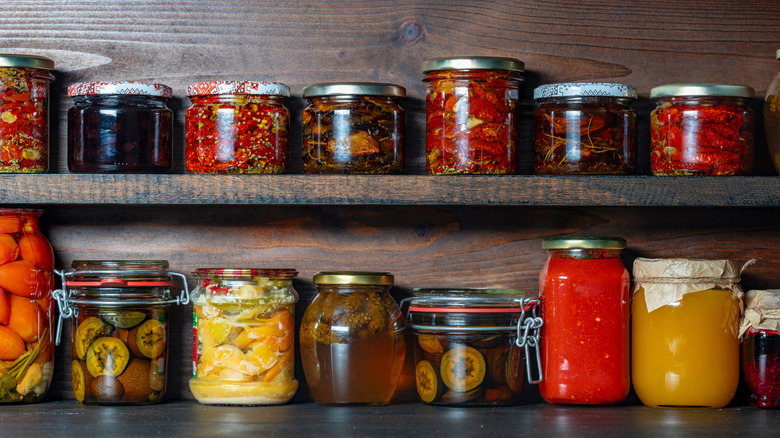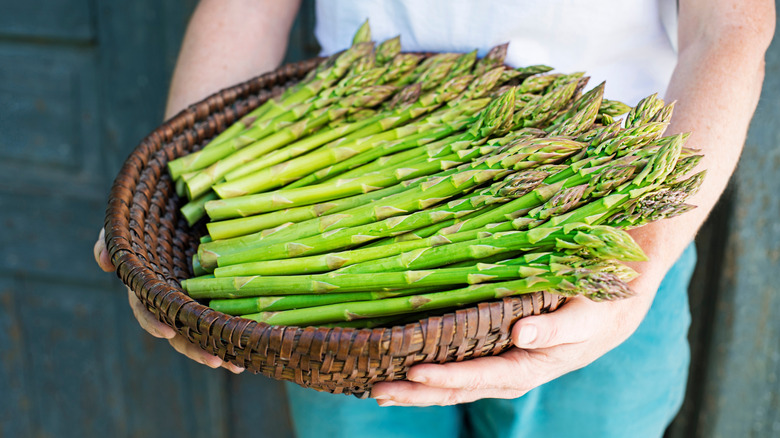Don't Throw Out Your Empty Pickle Jars, Do This Instead
Whether you love to eat one of the many different types of pickles as a snack or prefer them atop your favorite sandwich or burger, they're a food that is beloved for their sour, briny flavor and satisfying crunch. While pickles have many favorite flavors —from classic dill and half-sour to bread and butter to spicy — there is one thing that is usually consistent among the different varieties: the type of jar. The signature, wide-mouthed glass jars that pickles typically come in make them a great item to add to your next grocery list for more than just their flavor.
These versatile glass jars have nearly infinite uses both in and out of the kitchen. From the recyclable material to the screw-on lid to the spacious size, there are many pros to this type of jar that make them a smart style to have on hand. Read on to discover our favorite ways to repurpose your empty pickle jars.
Make single-serving overnight oats or chia seed pudding
Empty pickle jars are the perfect vessel for portioning out single-serve meals. And for breakfast, there's no better option than overnight oats or chia seed pudding. Both of these make-ahead recipes are nutritious and easy to prepare, so you'll have a healthy breakfast stocked in the fridge no matter how busy your morning may get.
You can even prep multiple breakfasts at the beginning of the week so you have them ready to go as soon as you wake up. Both overnight oats and chia seed pudding have basic formulas that you can tweak and customize to your own preferences. Chia seed pudding calls for chia seeds, your milk of choice, and a sweetener like honey or maple syrup. You can also add a splash of vanilla extract or some cinnamon. Overnight oats call for all of those same elements, but with the addition of rolled oats and some Greek yogurt.
Put all the ingredients in the jar, twist on the lid, and shake everything up. Then store it in the fridge overnight. You can add toppings like fresh or dried fruit, chocolate chips, nut butter, or nuts or seeds, too. Come morning, you'll have a customizable, delicious breakfast on the go.
Pre-pack salads that don't get soggy
Salads are the go-to lunch for many on busy work or school days. But pre-dressing your greens can lead to soggy lettuce — and packing extra tiny containers just for salad dressing can be tedious and lead to unwanted leaks in your lunchbox. Instead, add all your salad ingredients to an empty pickle jar for a convenient and mess-free alternative to Tupperware. Though this salad storage method is usually seen with mason jars, a pickle jar is the perfect low-waste alternative.
When using this method to pack a salad, you'll want to stack the ingredients with the wettest at the bottom of the jar (usually your salad dressing). Drop the dressing in first and then layer other ingredients like tomatoes, cucumbers, bell peppers, carrots, or any other veggies you choose, starting with the heartiest first and working your way up. When you're ready to eat, simply shake up the jar or dump everything out into a bowl and enjoy your ready-made lunch.
Jar homemade preserves or jams
If you enjoy making your own homemade jams and preserves, having several extra jars lying around is vital to packaging up your finished product. Because empty pickle jars usually have a wide mouth, they're ideal for spooning your concoction in without creating a mess.
If you're a newcomer to homemade jam or preserves, the recipe is simple: You just need fresh fruit, sugar, and lemon juice. The only difference between jams and preserves is the size of the fruit; jam has smaller pieces of fruit, while preserves have larger chunks. Bring the mix to a boil, and then simmer over medium heat until most of the liquid has evaporated. Eventually, you'll be left with a thick, sweet spread to use on toast or in desserts or to mix into your favorite yogurt. Before you start, just be sure to review common mistakes when making homemade jam.
Once ready, you can portion out the jam or preserve you plan to use immediately into empty pickle jars with a convenient screw-on lid. For jams you want to keep longer, you'll need sterilized jars with specific canning lids (like mason jars) that can be put into a canner or water bath.
Mix up your own salad dressing
A lidded glass jar, like an empty pickle jar, is perfect for mixing up your favorite homemade salad dressing. The airtight lid and wide mouth make it possible to add all the ingredients and just shake everything up, saving you from cleaning multiple dishes. Whether you're making an all-purpose vinaigrette or creamy Caesar dressing, you can easily add your oil, vinegar, and spices to the jar — and as an added bonus, the glass jar makes it easy to see how much you've put in if you're eyeballing it.
You can even use some of your leftover pickle juice in your dressing (either a vinaigrette or creamy variety) instead of plain vinegar. This adds briny, delicious flavor to your dressing that pairs perfectly with mild vegetables like cucumber, celery, or green beans. You can also go in the other direction and top your salad with a bold protein like buffalo chicken, an ingredient commonly found paired with pickles.
Store individual servings of soup
Soup is a versatile, delicious meal that is especially great for meal prepping because you can make it in large batches and portion it out for multiple days at a time. But one of the biggest challenges with soup is storage. Traditional plastic Tupperware containers often leak, and brightly colored soups like tomato or curry will leave unappetizing stains on the containers. The plastic also can release harmful substances like microplastics as it reheats, making it a less-than-ideal solution for packing up your delicious soup.
Empty pickle jars, on the other hand, are the perfect solution for soup storage. They allow you to create individual-sized portions you can pop in the fridge to have handy for your next meal. You can reheat the soup easily in the microwave straight from the jar (just be sure the glass is microwave safe and the lid is removed). You can even freeze extra portions for a versatile way to keep your leftovers fresh. If you plan to use the pickle jars in the freezer, just be sure to leave extra room for the soup to expand as it freezes, or you risk the jars breaking.
Keep fresh herbs from wilting
Fresh herbs add vibrant, fresh flavor to almost any meal. The only downside? Once you bring them home from the grocery store, they often wilt fast. Luckily, empty pickle jars are a convenient way to keep your herbs fresh and ready to use.
You can use the empty jar to store herbs in two different ways. For tender herbs like basil, parsley, cilantro, or mint, fill the jar with an inch or two of water. Wash and dry your herbs, trim the bottom of the stems, and submerge them in the water (just like you would a bouquet of flowers). Leave the lid off.
Hardy herbs, like rosemary or thyme, require a different storage method. Like tender herbs, you'll want to first wash and thoroughly dry them. Then, dampen a paper towel and wrap it around the herbs. Place the entire bundle into the jar and screw on the lid to prevent excess exposure to the air. These storage methods can seriously extend the shelf life of your herbs, keeping them fresh for weeks instead of days.
Store your own spice blends
With just a handful of spices, you can create endless flavor combinations that add pizazz to any meal. But measuring out multiple different spices can get tiring after a while, especially if you have a go-to combination you use time and time again.
Instead of redoing this tedious task over and over, you can create large-batch spice mixes from what is already in your pantry and ready to use. A few common blends you can create include Cajun seasoning, taco mix, or Italian seasoning. While you can always buy these pre-made at the store, mixing your own at home allows you to customize the levels of each individual spice, and it will typically save you money in the long run.
Empty pickle jars are the perfect vessel for these homemade blends; the wide mouth makes it easy to mix and scoop, the airtight lid keeps the spices fresh, and the glass won't hold or transfer any odors or flavors. If it's a blend you use very regularly, you can even poke holes into the lid of the jar to create a convenient, makeshift shaker.
Regrow your own scallions
Scallions (also known as green onions) have a mild onion taste that adds a touch of flavor to various dishes. From scallion-forward dishes like scallion pancakes to a light sprinkling of scallions as a garnish, it's a versatile ingredient that many professional and home chefs keep on hand.
If you like to use scallions to impart flavor into your cooking, you're in luck. Instead of rebuying bundles of scallions at the grocery store, all you need is an empty pickle jar to regrow them in the comfort of your own kitchen. Take a bunch of scallions (with the white ends and roots intact) and place them into a pickle jar filled with a few inches of water. Leave the jar on a windowsill or somewhere with a lot of direct sunlight. After a few days, the scallions will begin to grow, and you can cut off the tops of the scallions to use as you cook. You can take as much as 70% of the greenery without compromising the plant. Leave the rest in the jar to continue growing indefinitely. Just be sure to change out the water once a week.
Infuse your own liquor
Empty wide-mouthed pickle jars are the perfect airtight containers you need to create infused liquors. Whether you prefer vodka, rum, or gin, the glass jar allows you to infuse everything from fruit like pineapple or strawberry to spices like cinnamon, star anise, and allspice.
It's easiest to get strong infusions when using clear liquor (though it's possible to infuse dark liquor, too). Simply fill your jar with your chosen ingredients — be sure to wash and cut up any fresh fruit or vegetables. You can even use the pickle juice that was in the jar to infuse your liquor with a briny, herbaceous flavor. Then, fill the jar to the top with your chosen liquor, and screw on the lid so it's airtight. Store the jar in a dark, cool, and dry place (like a kitchen cabinet or a closet). Once it's infused to your desired level of flavor, strain out the add-ins, and it's ready to drink.
Make your own pickled veggies
An empty pickle jar — pickle juice included — can be reused to make your own pickles at home. The wide-mouthed, airtight pickle jar helps to keep the pickles fresh, and it's also the ideal vessel for hot pickling liquid if you choose to remake your own.
Pickle brine is very easy to make with basic pantry items. Just heat water, vinegar, sugar, and salt in a sauce pan. Though white vinegar is the most typical, you can sub in other alternatives like champagne or red wine vinegar for a subtle difference in flavor. Once the sugar has dissolved, the brine is ready; pour it into the jar over your chosen vegetables. From classic pickles made with cucumbers to other pickled veggies like carrots, peppers, or onions, you can pickle almost any hearty, fresh vegetable. You can even pickle more unconventional items like grapes, blueberries, or lemons. The sweetness of the fruit with the sourness of the brine creates a beautiful and unexpected balance.
Brew your own cold brew
Cold brew (not to be confused with iced coffee) is often accompanied by a high price tag at fancy coffee shops, so it can be an expensive daily habit. But luckily, it's easy to make your own at home and achieve the same rich, deep flavor; all you need is a few household items and your favorite coffee grounds.
Besides the coffee, the most important item you'll need is an empty, wide-mouthed glass jar with a screw-on lid — just like an empty pickle jar. First, add your coffee grounds to the jar. Then, top it with water. The ratio of coffee to water depends on how strong you like your coffee — some recommend 4 tablespoons of coffee for every 6 ounces of water, while others recommend a ratio of one part coffee to 3 parts water. Screw on the lid and put the jar into the fridge to let the coffee steep for at least 24 hours.
Once ready, you'll need to strain the coffee grounds from the water. Pour the contents of the jar through a coffee filter to catch the gritty grounds, and voila — your cold brew is ready to drink.
Store leftovers in the fridge or freezer
Glass containers are preferred for food storage thanks to the benefits of glass over plastic. Not only is glass a natural and sustainable material, but it also can withstand high heat without releasing chemicals (unlike some plastic). Because glass is non-porous, it doesn't trap bacteria either, and that helps keep your food tasting fresher. Glass is also typically dishwasher safe, making cleanup faster and easier than with plastic containers that often need to be hand washed.
While the benefits of glass over plastic are clear, there is one major downside: price. Glass containers are often more expensive than their plastic counterparts. But luckily, instead of spending money on new glass containers, you can reuse glass jars — like pickle jars — as an economical and eco-friendly alternative. You can pair your empty pickle jars with other upcycled glass jars from food like jam or pasta sauce or condiments like mayonnaise to stock up on a variety of shapes and sizes.
Cook perfectly tender asparagus
While jars might seem like they're only used for food storage, they can also be used in the cooking process. Though unexpected, an empty pickle jar is a vital tool for cooking asparagus using a tried-and-true 2,000-year-old method. Originally found in an ancient Latin cookbook called Apicius, this approach was brought to the modern era with a translation of the original text in the 1930s.
First, prepare the asparagus by washing them and cutting off the bottoms of the stalks. Then, place the spears upright (with the stems down) in an empty pickle jar. Then place the jar in a pot with a few inches of boiling water. This allows the bottom of the asparagus to cook in the boiling water while the tops of the spears are cooked by the steam. This results in asparagus that is tender at the base — but not limp, overcooked, and wilted at the thinner top.
